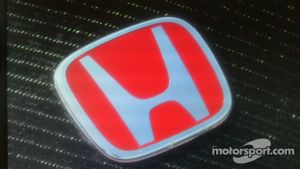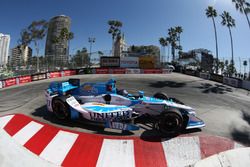What Honda still has to prove in IndyCar
With victory in the Indianapolis 500 achieved, it’s now time for Honda Performance Development's latest-spec engine to prove its mettle across all types of racetrack in the Verizon IndyCar Series, says David Malsher.

Photo by: IndyCar Series



















So now we know: Honda’s pace at Indianapolis Motor Speedway was genuine. Its teams’ paranoia over what Chevrolet might have in reserve was unnecessary.The eventually wearisome persecution complex over domed skids was unfounded.
And those of us who thought HPD could only win Indy in fortuitous circumstances were hugely wide of the mark.
So hang out the bunting, wave your giant ‘H’ flags and erect a statue of Art St. Cyr (HPD prez) in Torrance, Calif.
Does this mean that Honda-powered teams can be expected to compete without disadvantage on all types of track now? That’s the multi-million dollar question as we head straight into Motown’s double-header.
Ever since Chevrolet returned to IndyCar following the introduction of the 2.2-liter direct injection turbo V6 rules in 2012, the engine settings for ovals and for road/street courses have been roughly 100-120hp apart.
Back in ’12, the figures were roughly 550hp oval, 670 road/street, but as Chevrolet and Honda have improved their breed and become ever more confident of making these engines last the requisite 2500 miles, those numbers have risen.
Motorsport.com sources suggest these figures have risen to 620 and 720, plus or minus 10hp. For that alone, both manufacturers should be commended: that’s a hell of a jump in just four years of competition.
However, it wasn’t until Indy that HPD released its definitive 2016 spec unit, when all teams are granted a “free” engine change for the 500.
And incidentally, it’s understood that the similar but hitherto unspecified failures suffered by Mikhail Aleshin’s Schmidt Peterson Motorsports car and Ryan Hunter-Reay’s Andretti Autosport entry during practice at Indy, came while using several of the new engine’s parts but not using the definitive latest-spec engines per se.
All it meant was that Aleshin and Hunter-Reay simply received their free engine change a couple of days early.
So the definitive 2016-spec HPD engine has covered itself literally and figuratively in glory. Given that the quirks and nuances of racing can sometimes twist perceived reality, HPD’s 1-3-4-5 on the Indy grid was even more significant than its 1-2 finish on raceday.
Hinchcliffe’s pole position was Honda’s first in the IndyCar Series since Houston in 2014.
Changing figures at the top
This weekend at the two races comprising the Chevrolet Dual in Detroit, we’re set to find out how well HPD’s newest unit will work in road/street-course tune, which basically involves altering the inlet trumpets and cranking the turbo from 1.3- to 1.5-bar (1.65 with Push to Pass boost).
So far this year, Chevrolet has dominated qualifying and most race days, while Honda has flattered to deceive through practice sessions. It’s understood that Chevy retards its ignition during practice, losing up to two percent of its horsepower, and when that last bit of potential is unleashed, the Hondas have been left gasping.
So what has been that difference in power output? As you can imagine, one has to plow through a lot of ‘no comments’, ‘I don’t knows’ and ‘I could tell you but I’d have to kill yous’ before reaching anything resembling a definitive figure.
However, Motorsport.com has learned that in qualifying – the peak of disparity between Chevrolets and Hondas – the gap has hitherto been up to 32kW or 43hp.
Now you can see why Honda drivers were worried in the run up to the 500, even aside from the domed skids (non-) issue. Assuming that output differential is reduced proportionally to the tune of the car for an oval, that would have still left Honda 37hp short.
Up in the 220mph-plus range, every 7hp equates to 1mph around the Speedway, Honda cars would have been approximately 5mph slower than they were. Cut polesitter James Hinchcliffe’s lap speeds by 5mph and he would have scarcely outqualified two Chevy-powered cars.
What a drag
It’s not that simple though, because there’s an additional factor to be considered here, too: the drag of the aerokit.
If you find it hard to imagine that HPD has recouped its serious power deficit to Chevrolet in one hit, you can only conclude that the manufacturers’ very comparable speeds at Indy mean that the HPD/Honda Japan-produced aerokit for this year is exceptionally slippery in superspeedway form.
This is interesting, because that validates IndyCar’s decision in the off-season when implementing Rule 9.3. The governing body decreed HPD did not need help with its superspeedway kit and instead allowed Honda to catch up with Chevrolet in terms of its drag/downforce equation only for road/street/short-ovals.
Ironically, that’s where some say Honda is lagging badly, but the emphasis there is on the word “some”. Back in Phoenix, running the short-oval kit, personnel from Honda-powered teams were completely at odds as to why the top Honda in qualifying was 3.2mph slower than the top Chevy over two 1-mile laps.
One Honda team owner muttered, “Is it just me or are Honda even further behind than last year with their aerokit? It’s just so draggy.” Yet the lead Honda driver on that occasion, Marco Andretti, disagreed entirely. “It’s a power issue,” he said firmly, “we’re just way off. We’re fastest Honda and we’re 11th fastest.”
Last month, in his column for Motorsport.com, Marco expanded on his comment, pointing out the knock-on effect.
Describing the race, he said the Chevy cars “got great fuel mileage because they were able to lift going into corners because their power was keeping them out of our range. I’d be following a Chevy, I’d see the flame out the back as the driver was rolling off the throttle into the corner, and I’d still be hard on the gas but when we came out of the turn I hadn’t gained anything from the previous straight.”
Question marks and anomalies
There were similar comments at Long Beach, where Chevrolet locked out the Firestone Fast Six (despite promising practice form from Hinchcliffe and Graham Rahal) and after the race several Honda drivers commented they couldn’t keep up with Chevy drivers out of the slowest turns.
But how representative was that race when everyone’s pace was controlled by a ridiculous fuel-mileage number? The different corner-exit speeds were as likely to be a result of alternative fuel-save techniques as they were power characteristics.
Here's an apparent anomaly, though. How come someone who’s 40hp down can qualify in the top six at Barber Motorsports Park and fight for the win? Was Graham Rahal’s set-up so good that he was really carrying that much more speed through the corners than top Chevy drivers and all other HPD-powered drivers? It seems unlikely… although there is a caveat to that.
“The Hondas do have more drag than us, I think,” said one Chevy driver about a month ago, “but they also have 200lbs more downforce toward the front. They turn on their tires [raise them to operating temperature] quicker than we do, which is what you want for qualifying, and that balance also helps in the race because you get less understeer and don’t wear out the front tires so quick.
“Basically, until Chevy turns up our engines for qualifying, I’d say the two manufacturers have looked about equal overall. So if Honda got their engines matching ours, we’d have a fight.”
And that may be exactly what’s happened, judging by the manufacturers’ relative Indy 500 performances. If HPD’s engine improvements really do translate to the higher power engine settings of the road/street courses, Chevrolet may get beaten up in its own backyard this weekend.
At the very least, we should soon know a lot more…
Be part of Motorsport community
Join the conversationShare Or Save This Story
Subscribe and access Motorsport.com with your ad-blocker.
From Formula 1 to MotoGP we report straight from the paddock because we love our sport, just like you. In order to keep delivering our expert journalism, our website uses advertising. Still, we want to give you the opportunity to enjoy an ad-free and tracker-free website and to continue using your adblocker.



















Top Comments